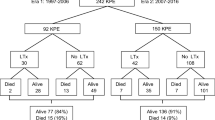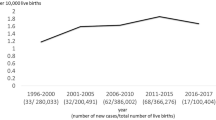Abstract
Purpose
Biliary atresia is managed surgically by the Kasai portoenterostomy (KP). It has been reported by some groups that the outcomes of patients who have an early failed KP requiring a liver transplant (LTx) within the first year of life are worse than the outcomes of patients who undergo a primary LTx. The aim of this study was to identify preoperative parameters that could help predict what patients are at risk for the early failure of the procedure.
Materials and methods
We conducted a retrospective chart review of all patients who underwent a KP between January 2008 and May 2018. The following preoperative parameters were analyzed: age at KP, anatomical variant of the biliary atresia, degree of liver fibrosis, CMV status, and PELD score. The main outcome of the study was the early failure of the KP (EF-K), which was defined as the need for LTx before 1 year of age, or BA-related death before 1 year of age. Second, we analyzed the risk factors associated with death without LTx within the first year of life.
Results
A total of 58 patients were included in the analysis. The native liver survival (NLS) was 56.5% and 48% at 1 and 5 years post KP, respectively. Overall survival (OS) was 79% and 76% at 1 and 5 years post KP, respectively. Early failure of KP occurred in 23 (39.7%) patients. OS in this group was 47% and 40% at 1 and 5 years, respectively. On the contrary, the OS of the remaining 35 (60.3%) patients was 100% at 1 and 5 years (P < 0.0001). When we compared all preoperative parameters, the only predictor of EF-K was the PELD score. When we analyzed the cases in the EF-K group who died without LTx, we found that the significant predictors were the cystic variant, a degree of liver fibrosis >4, and the PELD score. Nevertheless, on multivariate analysis, only PELD score was found as a statistically significant variable.
Conclusion
Due to bad prognosis found in EF-K patients, we believe that it could be reasonable to offer them a primary LTx. PELD score was found to be the strongest preoperative parameter that allows predicting which patient will likely have an early failed KP. Further prospective and multicenter studies are needed to reinforce these results.



Similar content being viewed by others
Abbreviations
- BA:
-
Biliary atresia
- KP:
-
Kasai portoenterostomy
- LTx:
-
Liver transplant
- EF-K:
-
Early failed Kasai
- NLS:
-
Native liver survival
- OS:
-
Overall survival
- PELD:
-
Pediatric end-stage liver disease
References
Davenport M, Ong E, Sharif K, Alizai N, McClean P, Hadzic N et al (2011) Biliary atresia in England and Wales: results of centralization and new benchmark. J Pediatr Surg 46:1689–1694. https://doi.org/10.1016/j.jpedsurg.2011.04.013
Superina R, Magee JC, Brandt ML, Healey PJ, Tiao G, Ryckman F et al (2011) The anatomic pattern of biliary atresia identified at time of kasai hepatoportoenterostomy and early postoperative clearance of jaundice are significant predictors of transplant-free survival. Ann Surg 254:577–585. https://doi.org/10.1097/SLA.0b013e3182300950
Superina R (2017) Biliary atresia and liver transplantation: results and thoughts for primary liver transplantation in select patients. Pediatr Surg Int 33:1297–1304. https://doi.org/10.1007/s00383-017-4174-4
Wang Q, Yan L, Zhang M, Wang W, Zhao J, Jin S (2013) Can primary LDLT be the alternative first line treatment for infant patients with biliary atresia? Hepatogastroenterology. https://doi.org/10.5754/hge12956
Alexopoulos SP, Merrill M, Kin C, Matsuoka L, Dorey F, Concepcion W et al (2012) The impact of hepatic portoenterostomy on liver transplantation for the treatment of biliary atresia: early failure adversely affects outcome. Pediatr Transplant 16:373–378. https://doi.org/10.1111/j.1399-3046.2012.01677.x
Neto JS, Feier FH, Bierrenbach AL, Toscano CM, Fonseca EA, Pugliese R et al (2015) Impact of Kasai portoenterostomy on liver transplantation outcomes: a retrospective cohort study of 347 children with biliary atresia. Liver Transplant 21:922–927. https://doi.org/10.1002/lt.24132
Chardot C, Buet C, Serinet MO, Golmard JL, Lachaux A, Roquelaure B et al (2013) Improving outcomes of biliary atresia: French national series 1986–2009. J Hepatol 58:1209–1217. https://doi.org/10.1016/j.jhep.2013.01.040
Czubkowski P, Cielecka-Kuszyk J, Rurarz M, Kamińska D, Markiewicz-Kijewska M, Pawłowska J (2015) The limited prognostic value of liver histology in children with biliary atresia. Ann Hepatol 14:902–909. https://doi.org/10.5604/16652681.1171781
Wiesner RH, McDiarmid SV, Kamath PS, Edwards EB, Malinchoc M, Kremers WK et al (2001) MELD and PELD: application of survival models to liver allocation. Liver Transplant. https://doi.org/10.1053/jlts.2001.25879
Pakarinen MP, Johansen LS, Svensson JF, Bjørnland K, Gatzinsky V, Stenström P et al (2018) Outcomes of biliary atresia in the Nordic countries—a multicenter study of 158 patients during 2005–2016. J Pediatr Surg 53:1509–1515. https://doi.org/10.1016/j.jpedsurg.2017.08.048
Wang Z, Chen Y, Peng C, Pang W, Zhang T, Wu D et al (2018) Five-year native liver survival analysis in biliary atresia from a single large Chinese center: the death/liver transplantation hazard change and the importance of rapid early clearance of jaundice. J Pediatr Surg. https://doi.org/10.1016/j.jpedsurg.2018.09.025
Nio M (2017) Japanese biliary atresia registry. Pediatr Surg Int 33:1319–1325. https://doi.org/10.1007/s00383-017-4160-x
Yang J, Gao W, Zhan J, Feng J (2018) Kasai procedure improves nutritional status and decreases transplantation-associated complications. Pediatr Surg Int 34:387–393. https://doi.org/10.1007/s00383-018-4228-2
Wang P, Xun P, He K, Cai W (2016) Comparison of liver transplantation outcomes in biliary atresia patients with and without prior portoenterostomy: a meta-analysis. Dig Liver Dis 48:347–352. https://doi.org/10.1016/j.dld.2015.11.021
Chung PHY, Wong KKY, Tam PKH (2015) Predictors for failure after Kasai operation. J Pediatr Surg 50:293–296. https://doi.org/10.1016/j.jpedsurg.2014.11.015
Lykavieris P, Chardot C, Sokhn M, Gauthier F, Valayer J, Bernard O (2005) Outcome in adulthood of biliary atresia: a study of 63 patients who survived for over 20 years with their native liver. Hepatology 41:366–371. https://doi.org/10.1002/hep.20547
Nio M, Ohi R, Miyano T, Saeki M, Shiraki K, Tanaka K (2003) Five and 10 year survival rates after surgery for biliary atresia: a report from the Japanese biliary atresia registry. J Pediatr Surg 38:997–1000. https://doi.org/10.1016/S0022-3468(03)00178-7
Davenport M, Caponcelli E, Livesey E, Hadzic N, Howard E (2008) Surgical outcome in biliary atresia: etiology affects the influence of age at surgery. Ann Surg 247:694–698. https://doi.org/10.1097/SLA.0b013e3181638627
Nakajima H, Koga H, Okawada M, Nakamura H, Lane GJ, Yamataka A (2018) Does time taken to achieve jaundice-clearance influence survival of the native liver in post-Kasai biliary atresia? World J Pediatr 14:191–196. https://doi.org/10.1007/s12519-018-0139-5
Weerasooriya VS, White FV, Shepherd RW (2004) Hepatic fibrosis and survival in biliary atresia. J Pediatr 144:123–125. https://doi.org/10.1016/j.jpeds.2003.09.042
Zani A, Quaglia A, Hadzić N, Zuckerman M, Davenport M (2015) Cytomegalovirus-associated biliary atresia: an aetiological and prognostic subgroup. J Pediatr Surg 50:1739–1745. https://doi.org/10.1016/j.jpedsurg.2015.03.001
Shinkai M, Ohhama Y, Take H, Fukuzato Y, Fujita S, Nishi T (2003) Evaluation of the PELD risk score as a severity index of biliary atresia. J Pediatr Surg 38:1001–1004. https://doi.org/10.1016/S0022-3468(03)00179-9
Rhu J, Jung SM, Choe YH, Seo JM, Lee SK (2012) PELD score and age as a prognostic index of biliary atresia patients undergoing Kasai portoenterostomy. Pediatr Surg Int 28:385–391. https://doi.org/10.1007/s00383-012-3060-3
Funding
The authors did not receive support from any organization for the submitted work. The authors have no relevant financial or non-financial interests to disclose.
Author information
Authors and Affiliations
Contributions
Study conception and design: CM. Data acquisition: CM. Analysis and data interpretation: HE, MJ. Drafting of the manuscript: CM, HE, MJ. Critical revision: AV, QH, CG, BM.
Corresponding author
Additional information
Publisher's Note
Springer Nature remains neutral with regard to jurisdictional claims in published maps and institutional affiliations.
Rights and permissions
About this article
Cite this article
Capparelli, M.A., Ayarzabal, V.H., Halac, E.T. et al. Preoperative risk factors for the early failure of the Kasai portoenterostomy in patients with biliary atresia. Pediatr Surg Int 37, 1183–1189 (2021). https://doi.org/10.1007/s00383-021-04933-y
Accepted:
Published:
Issue Date:
DOI: https://doi.org/10.1007/s00383-021-04933-y




